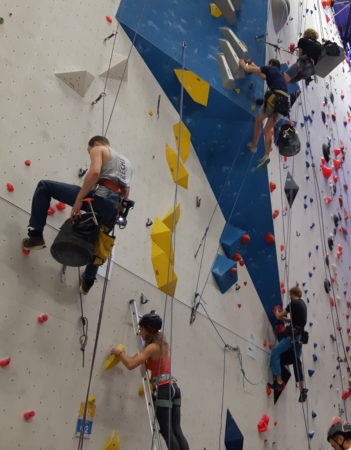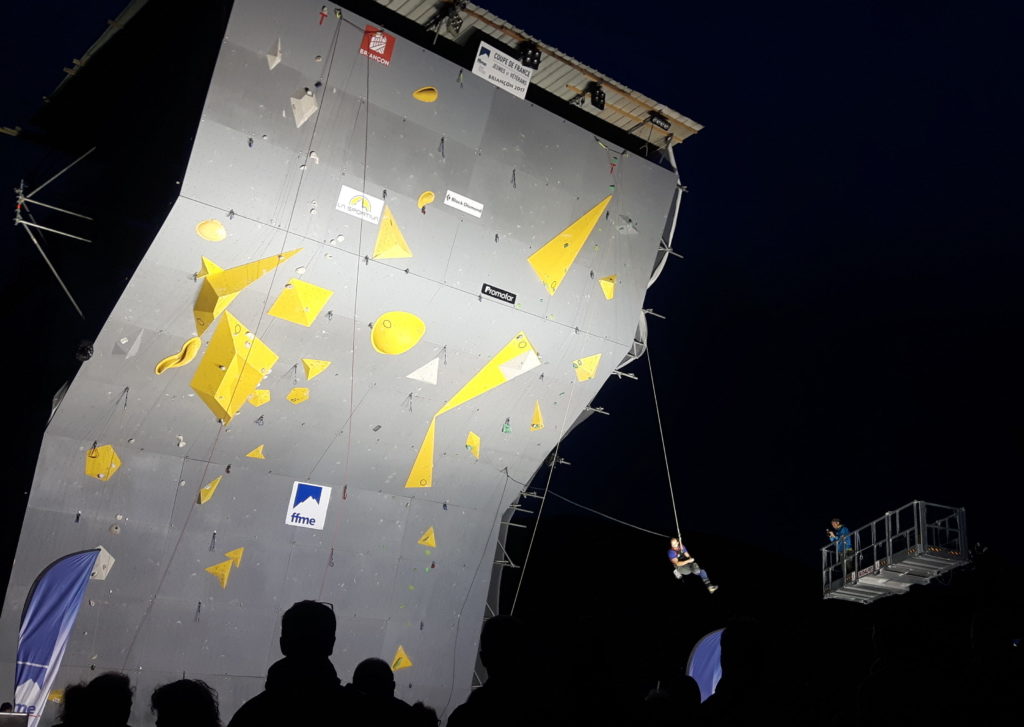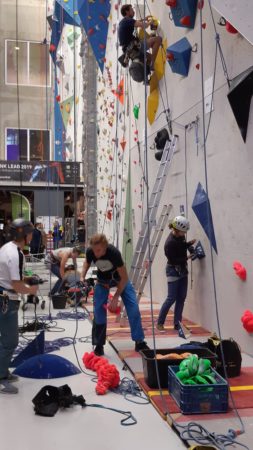Depending on the disability, the difficulty and the style (steep, vertical, traversing, slopers, jugs, corners) of a route which can be climbed by the athletes are very different. Just looking on the difficulty, some qualification routes start at 5c for sport classes which are affected hard by their impairment (RP1, AU1, AL1) and can reach up to 8b in finals for sport classes which are less affected by their impairment (AL2, RP3).
In IFSC competitions, there are two qualification routes and the best athletes will get into the final round. All difficulties noted here were observed in mens routes (womens routes are slightly easier in most sport classes) and estimated at competitions and may change over time. Competition routes are sometimes difficult to rate because their style is progressive (commercial gym routes are more the same difficulty from bottom to top) and depending on the route, not many athletes got to the finishing hold and could estimate the difficulty …

So if you ask “How hard do I have to climb to participate in international Paraclimbing competitions”, the answer is complex and begins with “It depends …”.
AL1 (sitting in a wheelchair, no control over their lower body) athletes campus everything. Overhanging walls are preferred so that legs won’t scratch over the wall.
AL2 (leg amputee, limb deficiency or leg length difference) athletes may choose if they want to climb with or without prosthesis. Routes must be set in a way that it is no difference if the athlete uses a prosthesis or not and if left or the right leg is missing. More footholds to allow alternate body positions can help a lot here. Traverses and corners can be very tricky for these athletes while overhanging walls are no problem at all. Difficulties range from 7a up to 8b in this sport class.
AU1 (upper arm amputee) can only use one arm for climbing. So the climbing style is campusing with one arm. Traverses, overhanging walls and big moves on big holds are not desired in this category. Putting more footholds can help athletes to position their body in a better way and to avoid left/right differences. It shall be no difference if the left or right arm is missing. Climbing difficulties range from 5c-6b in this sport class. (Please note the AU1 has been retired in 2023 and AU1 Athletes are climbing in 2023 from the 2023 season on. New since 2023: AU3!)
AU2 (lower arm amputee or limb deficiency) have one full arm and one stump to climb. The nature of this stump (length, diameter, pain resistance) can be very different and this decides also about the way it can be used as “hook”. The use of finger pockets and pinching is not possible with one arm, the athletes rely on precise footwork. Routesetting can avoid a lot of left/right differences by adding more footholds. Difficulties range from 6b to 7b in this sport class.
AU3 (finger amputee or limb deficiency) have an impairment of fingers and/or hand(s). They have a functional wrist in comparison to AU2. Routesetting shall avoid left/right differences and holds that are impossible to use like finger pockets or pinching.
B1 (blind, no vision left, climbing blindfolded) athletes can not see any holds and rely 100 % on their sight guide who directs the athletes through the wall. Blind athletes get (video) demonstrations of routes before, so the sight guide can memorize and train and visualize the moves with the athlete. B1 athletes climb usually more static and slow, difficulties range from 6a to 7a in this sport class.
B2, B3 (visually impaired, vision left) can see parts of the route on their own but rely also on their sight guide. Video demonstrations are available here like in B1. As B2 and B3 athletes have vision left, they can climb a bit more efficient and faster than B1 athletes. In order to give the athletes the best experience, a high color contrast in between wall/volumes and holds are very important. Difficulties range from 6b to 7b in this sport class.
RP1 athletes have major neurological or physiologic impairments which affects more or less the whole body. These limitations can be very different: Range of movement, coordination, flexibility, strength. Routesetters have to offer different options, more footholds can help to equalize the different capabilities as good as possible. In comparison to all other categories, RP1 is a very “wide” sport class, some athletes also need a wheelchair, the climbing style is slow and static. Difficulties range from 5c to 6c in this sport class.
RP2 athletes have medium neurological or physiologic impairments. In comparison to RP1, the limitations are less strong and/or affect not that many parts of the body. Difficulties range from 6b to 7b in this sport class.
RP3 athletes have only minor limitations and can climb normal routes. Difficulties range from 7a up to 8b in this sport class.
For all sport classes, routesetting shall make the beginning of routes very easy to avoid athletes falling to the ground and progress the difficulty towards the top in order to make a good separation among athletes.
If the walls are steep, two topropes are used. One from the top and a second one lower down which avoid falling to the ground or large pendulum falls in the beginning of the route.

Further information on Routesetting can be found in the official IFSC Paraclimbing Routesetting Guidelines.

